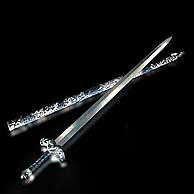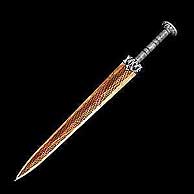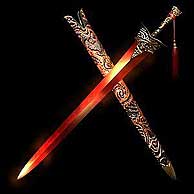Heritage
Ten famous swords in China's ancient times
Updated: 2011-02-16 10:43
By Yang Ping (chinaculture.org)
The sword of integrity: Qi Xing Long Yuan
 |
Legend has it that this sword was the joint work of two sword makers, Ou Yezi and Gan Jiang. In order to make it, they brought stream water from Cishan Mountain to the seven ponds around the sword-making fireplace. Because the seven ponds were shaped like the seven stars of the Big Dipper, the sword was named Qi Xing (seven stars). If you look down the sword, it looks ethereal and profound, as if you are in a high position overlooking a valley where a huge dragon lives, which is why the sword was also named Long Yuan (an abyss with a dragon).
According to theAnnals of Wu and Yue, another factor that made this sword famous was a fisherman whose name is unknown. He saved Wu Zixu’s life. In order to express his gratitude to the fisherman, who refused to tell his name, Wu sent him the sword, Qi Xing Long Yuan. The fisherman sighed and said, “I saved your life because you are a loyal official of the country, not because I wanted your reward. Now that you think I am a man longing for profits, I have to show my nobleness with this sword.” With these words, he committed suicide with the sword. Therefore, Qi Xing Long Yuan was a sword of integrity.
The sword of prestige: Tai E
 |
According to theLost History of Yue, the valuable sword Tai E was naturally made in the State of Chu. The King of the State of Jin, which was the strongest state then, was not happy about this and attempted to take possession of the sword by invading Chu. Besieged by the troops of Jin, the King of Chu was told to surrender and give the sword to Jin. Otherwise, his country would be doomed the next day. Instead of giving out the sword, the King of Chu, with the sword, led his army to defend his country.
It was a matter of minutes before Chu would be wholly occupied by Jin. On the verge of defeat, the King of Chu let out a long sigh and said to the sword: “Tai E, Tai E, today my blood will be offered as a sacrifice to you.” With these words, he took out the sword. The moment the blade was out, a miracle occurred: the soldiers of Jin were frightened into disarray, and killed with no one left alive. Surprised at this, the King of Chu asked: “Why was the sword so powerful?” and an advisor told him that its magic power was drawn from his own inner power—the courage to stand firm before a formidable enemy. Tai E was thus a sword of prestige.
The sword of sovereignty: Chi Xiao
 |
In the Qin Dynasty (221-207 BC), there was a young man who liked to talk big. One day he got a rotten steel rod and told people that it was a sword he got from an immortal living in Nanshan Mountain, and named it Chi Xiao, always carrying his “sword.” He also boasted that he was the incarnation of a red dragon from Heaven, and that he had known Emperor Qin, who, according to him, was the incarnation of a white dragon. He even said that the incarnation of the Emperor had turned from a white dragon into a white snake wandering around Feng Xize, claiming that he, with more magic power now than the Emperor Qin, would replace him as the emperor.
People all around knew that he was a braggart and did not believe his nonsense. However, people’s distrust toward him changed after what happened one night. On that night, a few dozen young people, including the braggart, carrying his sword, went to the town of Feng Xize to do some apprentice work. On the way there, they were confronted by a huge white snake. Terrified by it, no one dared to move. It was the braggart who volunteered to kill the snake, chasing it into the woods. The others waited for him to return, but he did not come back that night. Finally, they returned home, believing that he had become the supper of the snake.
The next day, people found the snake killed and the young man lying nearby. His rotten steel rod had been replaced by a glittering sword, with two characters on it reading: “Chi Xiao.” Astounded by this scene, people realized that what the braggart said was all true. The young man was Liu Bang, who later defeated Emperor Qin and founded the Han Dynasty. The sword Chi Xiao was the one he used to kill the snake and lead battles in his revolution against the emperor. Hence, the white dragon was replaced by Liu’s red dragon, and Chi Xiao became known as a sword of sovereignty.
The sword of kindness: Zhan Lu
 |
Zhan Lu was more like a pair of eyes than a sword. Black in color, the long, unmarked sword gave a sense of kindness and benevolence, rather than sharpness. Like Heaven’s deep and discernable eyes, the sword watched the behavior of kings. If a king had moral integrity, then the sword would be with him and his country would be prosperous; if the king didn’t have moral integrity, the sword would leave him and his country would fall apart. Upon finishing the sword, Ou Yezi could not help shedding tears, for he finally realized his lifelong dream: casting an unparalleled strong sword without a murderous appearance. Benevolence knows no enemy. Zhan Lu was a sword of kindness.
Specials

Spring Festival
The Spring Festival is the most important traditional festival for family reunions.

Top 10
A summary of the major events both inside and outside China.

A role model
Alimjan Halik had been selected as the "Cyberspace Personality Who Moved the Hearts of the Chinese in 2010".